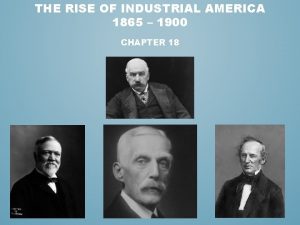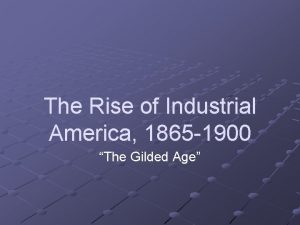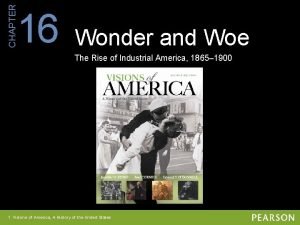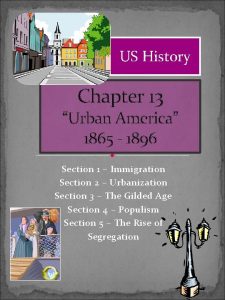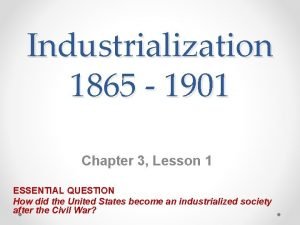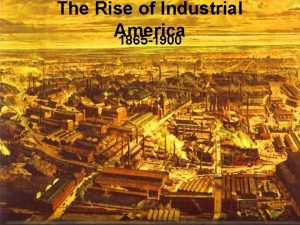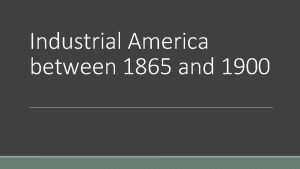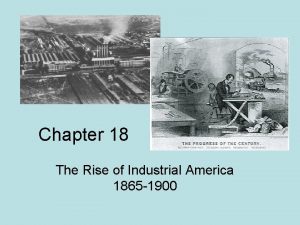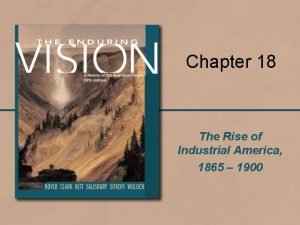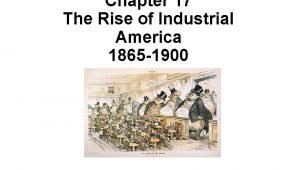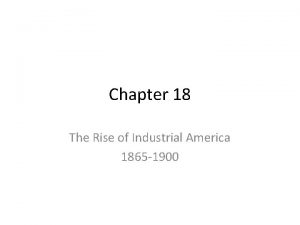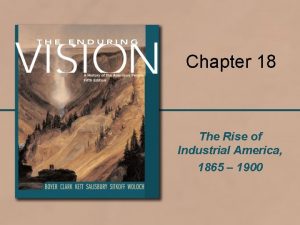The Rise of Industrial America 1865 1900 The










- Slides: 10

The Rise of Industrial America 1865 -1900

The Industrial Boom • The Civil War and the growth of railroads in the 1860 s contributed to the start of America’s Second Industrial Revolution (c. 1865 -1900) • Whereas America’s First Industrial Revolution of the early 1800 s had been characterized by steam powered textile factories in New England, the Second Industrial Revolution spread nationwide and was characterized by: 1. Exploitation of vast coal reserves (especially in Appalachia) 2. Technological innovations (transportation, communication) 3. Huge demand for labor (both skilled and unskilled) 4. Intense competition that led to the rise of monopolies 5. Rapid decline of prices (both agricultural and industrial) 6. Failure of the money supply to keep pace with expansion

The Railroad Industry • Expansion from 10, 000 miles of track in 1850 to nearly 200, 000 miles by 1900 – opened up a huge internal market that promoted farming, commerce, and closure of the frontier • Railroad companies were the first “modern” corporations – sought capital through stock issuances, separated ownership from management, created national distribution and marketing systems, established complex accounting methods, and formed new organizational structures • Railroads often went deeply into debt, relied on government subsidies (often in the form of real estate) and used questionable business practices to compete for business and profits; owners (such as Jay Gould of the Union Pacific) were depicted as “robber barons” who violated the public trust • Congress created the Interstate Commerce Commission in 1887 in an attempt to regulate railroad business practices that hurt small farmers and business owners in remote areas

Big Steel Andrew Carnegie led the industry in the late 1800 s thanks to the introduction of: 1. the Bessemer steel process high-quality steel 2. cost-analysis cut back costs, higher profits 3. vertical integration control of every stage of steel production from mining iron ore and coal to selling the finished product reduced costs and allowed Carnegie to under-price the competition through economy of scale monopoly control of the industry Overall result: More steel produced and at lower cost ($65/ton in 1875 vs. $11. 50/ton in 1900) Carnegie sold Carnegie Steel to J. P. Morgan and other investors in 1900 for $500 million and became a major philanthropist, advocated the “Gospel of Wealth”

Big Oil John D. Rockefeller sought control of the expanding industry through horizontal integration control of one stage of production (transportation and then refineries) Rockefeller established the Standard Oil Trust (1882) to control companies that had previously participated in price fixing arrangements (controlled 90% of the industry through horizontal and vertical integration) – emulated by other industries

Regulating Monopolies and Trusts • 1890 – Congress passed the Sherman Anti-Trust Act in an attempt to break up trusts and monopolies that were found to be operating “in restraint of trade” • To avoid being targeted by this legislation, Standard Oil reorganized into a holding company, whereby control was no longer exercised through direct ownership of companies but instead through majority share ownership • 1895 - the Supreme Court ruled in U. S. vs. E. C. Knight Company (a sugar trust) that manufacturing did not constitute interstate commerce and therefore could not be regulated encouraged further consolidation of industry into larger trusts

Invention & Innovation Major inventions enhanced productivity and improved the standard of living for most Americans: • Singer Sewing Machine Company first mass produced sewing machines in the 1860 s • Alexander Graham Bell invented the telephone in 1876 led to the creation of the Bell Telephone Co. (later, AT&T) • Thomas Edison invented the phonograph (1877), light bulb (1879), and developed the first power plant (1882) helped to create General Electric by 1892 with help from J. P. Morgan

Labor Issues • Demand for labor increased as demand for goods increased • One third of the workforce by the 1880 s was unskilled (common) labor that was easily replaced in the event of illness or strike • Three biggest problems: low wages, long hours, and unsafe conditions • Child labor was used intensively in mining and mill work lowered wages and resulted in a large number of crippled children • Immigrants and women accepted low wages and were often considered highly dispensable (as depicted in The Jungle) • Laborers were often at the mercy of laissezfaire capitalism, which drew upon Social Darwinism (survival of the fittest)

The Labor Movement National unions emerged in the late 1800 s to lead the charge for better working conditions: National Labor Union (est. 1866) by William H. Sylvis to campaign for an 8 -hour day, higher wages, and more recognition for women workers Knights of Labor (est. 1869) demanded equal pay for women, an end to child labor, an income tax, and immigration restrictions; Terence Powderly led the union to victory in the Wabash strike of 1883 -84 but the union declined as a result of failed strikes and growing national concerns over labor violence American Federation of Labor (est. 1886) created for skilled labor; Samuel Gompers led a moderate effort for higher pay, shorter hours, and safer conditions

Labor Strikes & Violence Middle-class Americans grew increasingly wary of radical words and actions from the labor movement; reflected a growing fear of socialism, Marxism, and anarchism Major outbreaks of violence included: 1. 1877 – wage reductions led to a wildcat railroad strike in the midst of a difficult depression (caused by the Panic of 1873), nearly 100 died before U. S. troops intervened 2. 1886 – Haymarket Square Riot in Chicago linked to radical anarchists; increased fears of social revolution 3. 1892 – Homestead Strike at the Carnegie Steel plant led to a shoot-out between strikers and Pinkerton agents called in to protect the plant 4. 1894 – Pullman Strike led by the American Railway Union (Eugene V. Debs), President Cleveland invoked the Sherman Anti-Trust Act against the union and broke up the strike with federal troops
 Four features of industrial manufacturing (1865-1900)
Four features of industrial manufacturing (1865-1900) The rise of industrial america 1865-1900
The rise of industrial america 1865-1900 1865 to 1900 inventions
1865 to 1900 inventions The rise of industrial america chapter 16
The rise of industrial america chapter 16 Urban america 1865 to 1896
Urban america 1865 to 1896 Rise and rise again until lambs become lions origin
Rise and rise again until lambs become lions origin Rise and rise again until lambs become lions
Rise and rise again until lambs become lions Tricky dick: the rise and fall and rise of richard m. nixon
Tricky dick: the rise and fall and rise of richard m. nixon Rise and rise again until lambs become lions
Rise and rise again until lambs become lions Industrialization (1865 to 1901 worksheet answers key)
Industrialization (1865 to 1901 worksheet answers key) Gregor mendel 1865
Gregor mendel 1865
